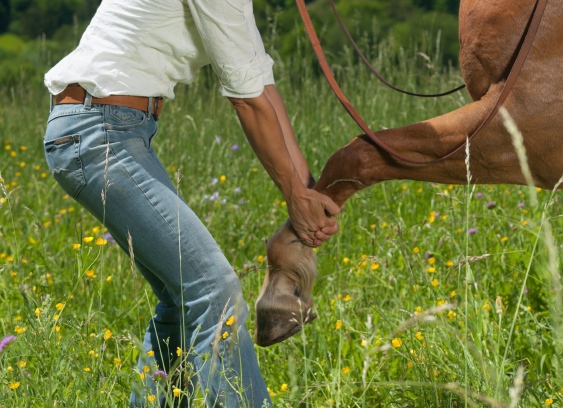
Don’t do this!
There are many benefits of stretching for horses. Keeping muscles supple, joints mobile and encouraging proper fibre alignment in healing tissues are key among them.
But to reap the benefits – and most importantly to avoid doing harm – it is essential that stretches be executed properly. Safety, for horse and human, are paramount.
The best way to learn stretches is firsthand, from a qualified therapist or other professional. Books, blogs and articles can be helpful too, but make sure you are getting your information from a credible source.
Carrot stretches are among some of the safest to perform, but others, such as those that stretch the limbs, require some extra precautions.
With that in mind, here are some of the top things you definitely want to avoid.
1. Holding tendons — not a good idea
The horse’s flexor tendons (which run along the back of the legs below the knee and hock), are actually part of the flexor muscles — the very muscles that are being targeted with stretches that take either the foreleg out in front of the body, or the hind leg forward underneath the belly. For this reason alone, you don’t want to be hanging on to them, restricting the stretch. They are also more vulnerable structures too. Instead, place a supporting hand under the knee or fetlock joint.
2. Don’t put yourself in a vulnerable position
Horses can at times act in unpredictable ways – and quickly – so it’s important to always leave yourself room to get out the way if necessary. To maintain stability and save your back, give yourself a solid and wide base of support by spreading your feet and maintaining good anatomical alignment in your body. A stance approaching a lunge is often most appropriate when bringing the limbs forward. You want to be in a strong and solid position if the horse really leans into the stretch, which is not uncommon. Lastly, don’t work with a horse that you do not feel comfortable and confident with. If a horse has a tendency to kick, then hind limb stretches are not worth the risk.
3. Ditto for your horse
Whatever the type of stretches, the horse should be standing square on level, non-slip ground so they can comfortably maintain their balance throughout the exercise. A horse that isn’t standing square is not going to get an even or as effective a stretch either. The joints of the limb should always be kept in anatomical alignment (for example, the hock only opens and closes on a forward and back plane – it does not provide side-to-side movement as the ball-and-socket joint of the hip allows). Where a horse is recovering from injury or neurologic disease, always check with your vet first to make sure a given stretching regime is appropriate and not going to cause any harm.
4. Don’t stretch a cold muscle
Muscles are more extensible when they are warmed up with improved blood flow. For this reason it is a good idea to walk your horse for a few minutes, at a minimum, before performing stretches. This is particularly important for limb stretches, which are considered “passive” in that it is the handler that brings the leg into the stretching position. Carrot stretches, on the other hand, are considered “active” because the horse plays an active role in assuming the position (even if lured by a carrot) – and therefore can control the degree of the stretch.
5. Don’t force a stretch beyond the horse’s range of comfort
As with many things horse-related, the principle of allow, don’t force applies. This is especially important for stretches where forcing a horse beyond their range of comfort could result in injury. The key is to progress gradually, and sometimes it will take a few sessions for the horse to become comfortable with the exercise. When they can sense the stability in your support, and are comfortable with the exercise, they will often get right into it. Over time, when practiced regularly, you will often find their range of motion improves.


